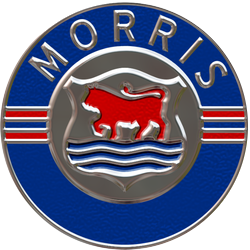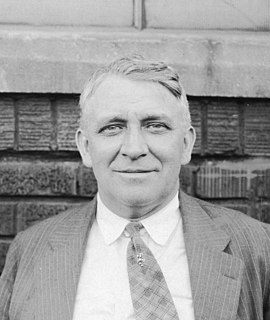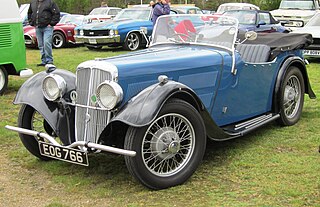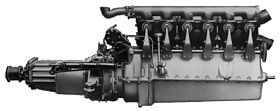
The Birmingham Small Arms Company Limited (BSA) was a major British industrial combine, a group of businesses manufacturing military and sporting firearms; bicycles; motorcycles; cars; buses and bodies; steel; iron castings; hand, power, and machine tools; coal cleaning and handling plants; sintered metals; and hard chrome process.

A flat-twin engine is a two-cylinder internal combustion engine with the cylinders on opposite sides of the crankshaft. The most common type of flat-twin engine is the boxer-twin engine, where both cylinders move inwards and outwards at the same time.

Morris Motors Limited was a British privately owned motor vehicle manufacturing company formed in 1919 to take over the assets of William Morris's WRM Motors Limited and continue production of the same vehicles. By 1926 its production represented 42 per cent of British car manufacture—a remarkable expansion rate attributed to William Morris's practice of buying in major as well as minor components and assembling them in his own factory. Self-financing through his enormous profits Morris did borrow some money from the public in 1926 and later shared some of Morris Motors' ownership with the public in 1936 when the new capital was used by Morris Motors to buy many of his other privately held businesses.

The Daimler Company Limited, prior to 1910 The Daimler Motor Company Limited, was an independent British motor vehicle manufacturer founded in London by H. J. Lawson in 1896, which set up its manufacturing base in Coventry. The company bought the right to the use of the Daimler name simultaneously from Gottlieb Daimler and Daimler-Motoren-Gesellschaft of Cannstatt, Germany. After early financial difficulty and a reorganisation of the company in 1904, the Daimler Motor Company was purchased by Birmingham Small Arms Company (BSA) in 1910, which also made cars under its own name before World War II. In 1933, BSA bought the Lanchester Motor Company and made it a subsidiary of Daimler Company.

The Austin Motor Company Limited was a British manufacturer of motor vehicles, founded in 1905 by Herbert Austin. In 1952 it was merged with Morris Motors Limited in the new holding company British Motor Corporation (BMC) Limited, keeping its separate identity. The marque Austin was used until 1987. The trademark is currently owned by the Chinese firm SAIC Motor, after being transferred from bankrupt subsidiary Nanjing Automotive which had acquired it with MG Rover Group in July 2005.

Frederick William Lanchester LLD, Hon FRAeS, FRS, was an English polymath and engineer who made important contributions to automotive engineering and to aerodynamics, and co-invented the topic of operations research.

Argyll was a Scottish motor car marque manufactured from 1899 to 1932, and again from 1976 to around 1990.
The Lanchester Motor Company Limited was a car manufacturer located until early 1931 at Armourer Mills, Montgomery Street, Sparkbrook, Birmingham, and afterwards at Sandy Lane, Coventry England. The marque has been unused since the last Lanchester was produced in 1955. The Lanchester Motor Company Limited is still registered as an active company and accounts are filed each year, although as of 2014 it is marked as "non-trading".

Wolseley Motors Limited was a British motor vehicle manufacturer founded in early 1901 by the Vickers armaments combine in conjunction with Herbert Austin. It initially made a full range, topped by large luxury cars, and dominated the market in the Edwardian era. The Vickers brothers died and, without their guidance, Wolseley expanded rapidly after the war, manufacturing 12,000 cars in 1921, and remained the biggest motor manufacturer in Britain.

Phelon & Moore manufactured motorcycles in Cleckheaton, Yorkshire, England from 1904 to 1967 particularly those under the Panther marque. They became identified with one particular design of motorcycle which had a large sloping 40-degree single-cylinder engine as a stressed member of the frame. This design spanned the entire history of the company, starting with a 500 cc model and ending with a 645 cc model.

The Westcott was an automobile produced in Richmond, Indiana and Springfield, Ohio in the United States between 1909 and 1925 by the Westcott Motor Car Company. The car company was named for its founder, John Westcott.

Frederick Samuel Duesenberg was a German-born American automobile and engine designer, manufacturer and sportsman who was internationally known as a designer of racecars and racing engines. Duesenberg's engineering expertise influenced the development of the automobile, especially during the 1910s and 1920s. He is credited with introducing an eight-cylinder engine, also known as the Duesenberg Straight-8 engine, and four-wheel hydraulic brakes, a first for American cars, in addition to other mechanical innovations. Duesenberg was also patentholder of his designs for a four-wheel hydraulic brake, an early automatic transmission, and a cooling system, among others. Fred and his younger brother, August "Augie" Duesenberg, shared the patents, filed in 1913 and renewed in 1918, for their "walking beam" four-cylinder engine and the Duesenberg Straight 8.

The SCAT was an Italian automobile manufacturer from Turin, founded in 1906 by Giovanni Battista Ceirano.
Laurence Henry Pomeroy (1883–1941) was an English automotive engineer trained as a locomotive engineer and particularly interested in the introduction of light alloys into automotive applications.

Bradbury Motor Cycles was a British motorcycle manufacturer based in Oldham, England and established in 1902. Originally involved in the manufacture of machine tools, sewing machines and cycles, their first motorcycles were bicycles with clip-on Minerva engines. The Bradbury factory went on to develop and produce a range of single-cylinder motorcycle, V-twins and horizontally opposed twins. The 1912 Bradbury motorcycles were one of the earliest with variable gearing. Although the factory survived the First World War it closed in 1924.
George Herbert Lanchester, was an English engineer. He was one of three brothers who played a leading role in the early development of the UK auto-industry.
The Norman Thompson Flight Company was a British aircraft manufacturer specialising in the construction of flying boats. It was formed as the White and Thompson Company in 1912, and designed and built the Norman Thompson NT.4 patrol aircraft and the N.T.2B flying boat trainer for the Royal Naval Air Service during the First World War, but production problems led to the company entering receivership in 1918, being liquidated in 1919.

BSA cars were manufactured between 1907 and 1912 in Birmingham then until 1939 in Coventry as well as Birmingham, England. BSA had established a motor-car department in an unsuccessful effort to make use of the Sparkbrook Birmingham factory. An independent part of the same site was occupied by The Lanchester Motor Company Limited. Sales were handled by BSA Cycles Limited. After 1912, manufacture was carried out by group subsidiary Daimler in Coventry or BSA Cycles in Birmingham.

Daimler Straight-Eight engines were eight-cylinder in-line petrol engines made by the Daimler Company to power the largest and most expensive cars in their range. The Straight-Eight engines replaced Daimler's earlier Double-Six V12 engines. Unlike the Double-Six engines, which used sleeve valves based on the Knight patents, the Straight-Eights used conventional poppet valves in the overhead valve configuration.
Henry Jones Lanchester (1834–1914) F.R.I.B.A was an English architect and surveyor. Most of his building work was carried out in Greenwich and Hove.
















